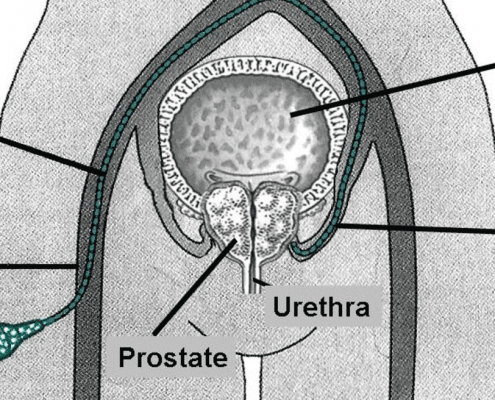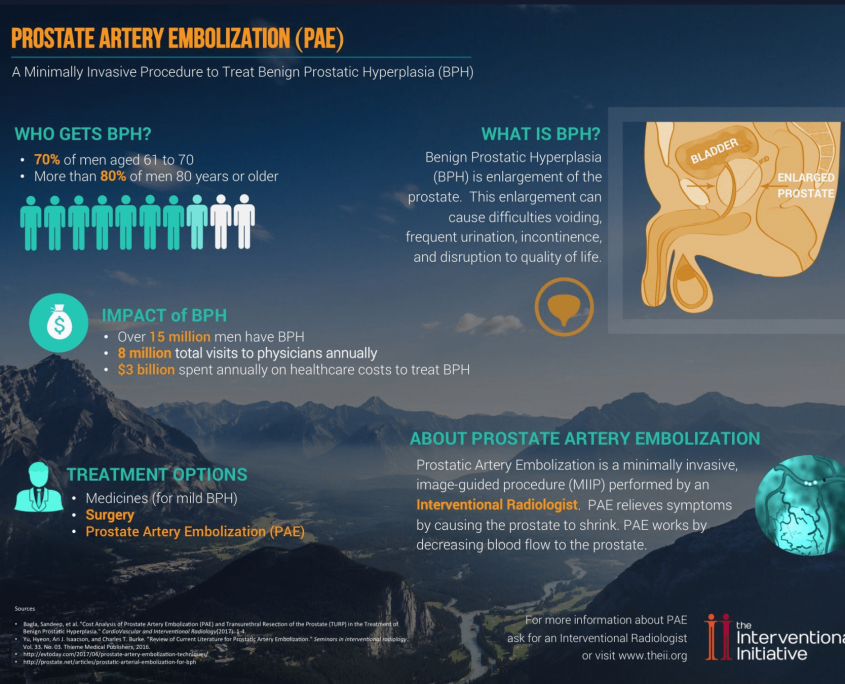What is Prostate Artery Embolization (PAE)?
Prostate artery embolization is a non-surgical alternative to TURP in treating an enlarged prostate (BPH) by blocking off the arteries that feed the gland and making it shrink. PAE was first performed in 2009.
Contact us today to see if you are candidate for PAE.
How is Prostate Artery Embolization performed?
This is a non-surgical procedure that is performed under an X-ray. You will lie on the X-ray table on your back. You will receive sedative and pain medication through an IV to make you comfortable and sleepy.
The skin and deeper tissues over the artery in the groin will be anesthetized with local anesthetic, and then a needle will be inserted into this artery. This will be the only area exposed as the rest of your body will be covered with a sterile drape. Then the needle is withdrawn allowing a fine, plastic tube, called a sheath, to be placed over the wire and into this artery.
The interventional radiologist then works through this sheath using small wires and catheter to get into the arteries feeding the prostate. These arteries are quite small and rather variable. A special X-ray dye, called contrast medium, is injected down the catheter into these prostate arteries, and this may give you a hot feeling in the pelvis. Once the prostate blood supply has been identified, tiny particles are injected through the catheter into these small arteries and blocks them so that the prostate is starved of its blood supply.
At the end of the procedure, all of the wires and catheter are removed.
How do I prepare for Prostate Artery Embolization?
You need to be admitted to the hospital. This can be done as a day case procedure or with an overnight stay if you are traveling or are on your own at home. You will probably be asked not to eat for six hours beforehand, though you may be told that it is alright to drink some water. You may receive a sedative to relieve anxiety. You will be asked to put on a hospital gown. As the procedure is generally carried out using the artery in the groin, you may be asked to shave the skin around this area.
If you have any allergies, you must let your doctor know. If you have previously reacted to intravenous contrast medium, the dye used for kidney x-rays and CT scanning, then you must also tell your doctor about this.
Does PAE hurt?
When the local anesthetic is injected, it will sting for a few seconds, but this soon passes, and the skin and deeper tissues should then feel numb.
As the dye, or contrast medium, passes around your body, you may get a warm feeling, which some people can find a little unpleasant. However, this soon passes and should not concern you.
How long does PAE take?
Every patient’s situation is different, and it is not always easy to predict how complex or how straightforward the procedure will be. Some prostate artery embolizations do not take very long, perhaps two hours. Other embolizations may be more involved, and take rather longer, perhaps up to three hours.
What happens after a PAE procedure?
You will be taken back to the recovery are. Nurses in the recovery area will carry out routine observations, such as taking your pulse and blood pressure, to make sure that there are no untoward effects. They will also look at the skin entry point to make sure there is no bleeding from it. Once any pain is controlled you will be transferred to your hospital room. You will generally stay in bed for a few hours, until you have recovered. If suitable for a day case procedure you will usually be allowed home after four to six hours. If not you will be kept in hospital over night. Once you are home, you should rest for three or four days. You will be prescribed painkillers if required and other drugs and an explanation of their usage will be given prior to your discharge.
What are the results of Prostate Artery Embolization?
Prostate artery embolization (PAE) has evolved into an encouraging minimally invasive option for patients suffering from a variety of prostatic issues, including lower urinary tract symptoms (LUTS) secondary to benign prostatic hyperplasia (BPH), hematuria of prostatic origin, and prostate cancer.
There are two medium term studies of the results of prostate artery embolization. Over 70% of men will gain symptomatic improvement after PAE with reduction in prostate volumes and an increase in urinary flow rates, without sexual dysfunction. Difficulty in finding the small prostate arteries may lead to technical failures in around 10% of cases. In case of failure traditional TURP surgery may be offered.
PAE is a safe procedure, designed to improve your medical condition and save you having a larger operation. There are some risks and complications involved, and you do need to make certain that you have discussed all the options available with your doctors.
What are the risks of PAE versus surgical TURP?
Due to the safety, low morbidity and good long-term results, prostate artery embolization is well-accepted by patients with benign prostatic hyperplasia. Major complications are rare however there are some risks and complications that can arise, as with any medical treatment.

More serious complications are associated with non-target embolization of the particles to the bladder, rectum, and penis. Ischemia to these organs is always possible and is minimized by direct visualization under x-ray and confirmation with CT images for a more predictable embolization.
Most men don’t want traditional surgery because it involves greater risks, has possible sexual side effects, and has a recovery time that is relatively longer than PAE, which is generally performed under local anesthesia and on an outpatient basis.
There may occasionally be a small bruise, called a hematoma, around the site where the needle has been inserted, and this is quite normal. If this becomes a large bruise, then there is the risk of it getting infected, and this would then require treatment with antibiotics.
Most patients feel some pain afterwards; this is usually mild. Very occasionally a urinary catheter may need to be placed.
There are complications possible with any medical procedure and PAE is no exception. Complications include problems related to general anesthesia and cardiovascular problems such as heart attack, stroke, deep vein thrombosis and pulmonary embolus. These problems rarely occur, and the risk depends on the patient’s general fitness for surgery and previous medical problems.
Who will be performing the prostate artery embolization?
A specially trained doctor called a Vascular and Interventional Radiologist. Interventional Radiology (IR) refers to a range of techniques which rely on the use radiological image guidance (X-ray fluoroscopy, ultrasound, computed tomography [CT] or magnetic resonance imaging [MRI]) to precisely target therapy. Most IR treatments are minimally invasive alternatives to open and laparoscopic surgery and start with passing a needle through the skin to the target.
The above information about prostate artery embolization (PAE) explains what is involved and the possible risks. It is not meant to be a substitute for informed discussion between you and your doctor, but can act as a starting point for such a discussion.
Research Papers:
Prostate Artery Embolization Paper
Prostate Artery Embolization SIR Paper
Prostate Embolization Erectile Dysfunction Improvement






